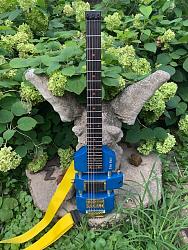
First, the backstory. Way back in the rad era Westone produced a bass that they called (X800) The Rail, so named for obvious reasons. The stainless steel tubes allow the pickup block to slide, but their primary function is resonate at a complimentary frequency. Combine this and pickup position and you can find the tonal sweet spot for nearly any string and amp combo. Also back in the rad era I bought the white one mostly because it was rad, but also because it sounds great.
The chief boffin at St Louis Music, the US importer/designer and the guy who invented the Rail bass were working on a guitar version when the Matsumoku factory was closed after the land was sold, but never resolved the resonation problem so it never went into production. The same product that was great for the bass was not good for the guitar. Only one prototype was known to have been built, and it only appeared in one magazine article circa 1986, so my only references were low-res scans of low-res magazine photos and my Rail basses.
Fast forward to 3 years ago when I decided to build some of the guitars I want but either can't afford or that don't exist. Naturally, the first one was going to be a Rail guitar. The prototype used the hardware from a Washburn headless guitar (also MFG by Matsumoku) because was on hand, but I modeled mine after the bass, assuming that a production version would as well. I went with brass instead of aluminum as the bass has because I like working with brass more and because brass is more conducive to the smaller scale of the hardware and to the higher frequencies of a guitar. The nut is made from a oillite bronze bearing. It would have been easier to make one out of graphite like the bass, but I was already making a bronze nut for my S.D. Curlee bass restoration, and had two blanks prepped. It looks great with the brass hardware.
I bought a Kmise Ibanez replacement guitar neck, chopped off its head, took the tuning machines from an Overlord of Music headless guitar kit, new bolts & screws, and an EMG passive pickup kit, but the rest is scratch. 304 stainless steel tubes, stuffed full with rock maple dowels; rock maple body; brass hardware, mild steel string clamp and neck plate. I had it painted BMW M3 Laguna Seca Blue by a friend who owns a body shop. Why smurf blue? Because I wanted it to be blue to look right with my red, white and black Rails (the only colors they came in), and LSB is the most glorious blue ever.
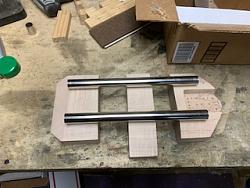
I made some tools for this build. The handle from a chip brush became a radius gauge for the body corners. I measured all three of the Rail basses that I had and they were all different (Matsumoku was the first to use CNC for guitar bodies, but they were all hand made otherwise), so I made the template an average of them all. One profile for the front and one for the rear.
I cut the string clamp from a piece of mystery steel that was close to the desired thickness, so it was easy to trim to size.
This photo shows how the clamp works. The strings hook onto the edges of the holes through the base, and the clamp prevents them from backing out.
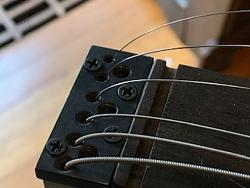
The bridge unit in exploded form before final sanding and polishing.
Another part and another tool. The part is a threaded insert for the knob that holds the sliding pickup block in place, and the tool is the installer. The insert sits just shy of the surface. The tool is held to the insert with a bolt. Keep this between us, but the outside is Imperial thread, but the inside is metric. This is because I don't have a course metric threading die. Shhh.
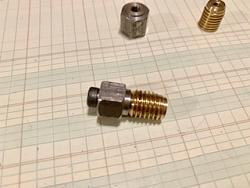
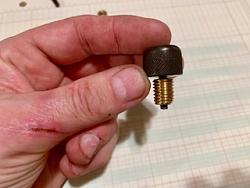
I made the knobs in bulk, and I made extras. One for practice, three for this guitar, and two spares in case I stuffed any. One is on the red Rail bass now. I don't yet have a knurling tool that is course enough to replicate the Westone "Speed Demon" knobs, but they work.
The body segments are held to the rails by standard 4mm wood screws, but have very thick brass washers to distribute the load. They work very well.
The strap buttons on the Westone headless basses are bespoke, and no one makes replicas (too bad, since they are superior to the common Gibson and Fender type, so I made my own. I got surprisingly close considering my lathe is ancient and worn. I cut a contoured tool to make the inside radius and step. A few weeks ago I made another tool to automatically cut the slight angle on top, but still need to trim it to cut the radius around the edge, too. I hope to produce them in batches to sell to Westone headless bass collectors (all 3 of us). The black one is an original.
This is a plug that I made to cover the truss rod adjuster. Westone's headless basses had the adjuster at the heel, but at the time I wasn't ready to make my own necks from scratch (I am now), thus using an Ibanez neck. BTW, I used Ibanex because their profile and dimensions are very closed to Westone guitar necks.
A glamor shot of the hardware after final polishing. The neck plate (far right) cut from a treadmill frame.
I'm currently working on two instruments - an aluminum-bodied Gibson Moderne homage (I modified the body shape, size and orientation to the neck to correct the visual imbalance, but keeping the Gumby headstock, of course), and a short-scale, 6-string, lefty beluga bass. I'll post the Moderne at some point.
Neil



 LinkBack URL
LinkBack URL About LinkBacks
About LinkBacks
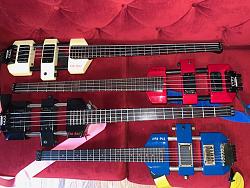
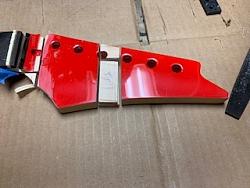
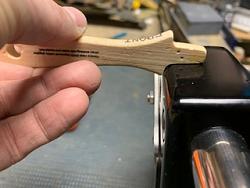
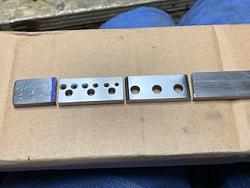
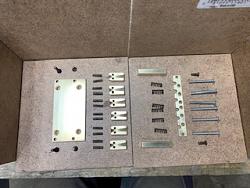
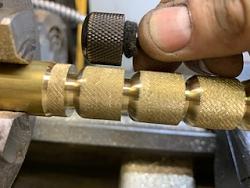
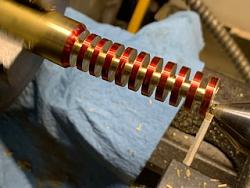
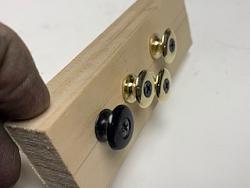
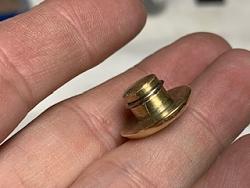
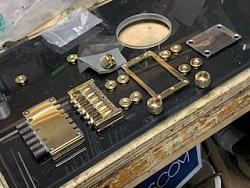


 Reply With Quote
Reply With Quote
Bookmarks